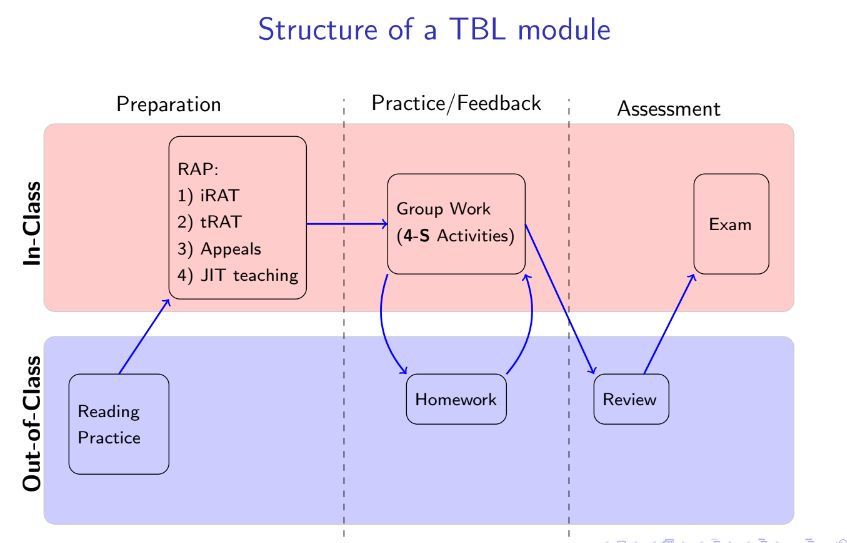*update 06-23 with notes for today’s TB(I)L talk
Team-Based (Inquiry) Learning 06-23
- I wanted to give this talk to demonstrate the work we’re doing on NSF DUE Award #2011807. We’re approaching things differently, but in the same spirit, as many other approaches you’ve heard about. The purpose of this talk is to help authors / developers think flexibly about their products and the differet ways they may be employeed in a classroom.
- History
- Team-Based Learning (history, definition) was created in 1979 by Professor of Business Management Larry Michaelsen to scale higher-order thinking to large classrooms.
- It expanded to other areas of instruction, and eventually the Team-Based Learning Collaborative was organized.
- It has particular popularity in nursing schools; my institution has a strong nursing program, so our most recent QEP which was running strong when I joined South was focused on training faculty to use TBL.
- Along with a colleague I was trained on canonical TBL, and thought it had potential to provide scaffolding to implement Inquiry-Based Learning in the freshman/sophomore courses I teach most, incorporating the very specified TBL structure into the big-tent IBL approach (honoring the four pillars of IBL). We called this TBIL and published on the framework in PRIMUS.
- We had some limited evidence that TBIL improved flexible problem-solving in our students, so we applied (many times) for an NSF IUSE grant and finally were funded in fall 2020 focusing on single-variable calculus and linear algebra. Our project website is here.
- My primary role in the project is focused on faculty development, materials authoring/editing, and cyberinfrastructure. We had 12 participating faculty in 2021-22 and about 18 in 2022-23.
- Learning Outcomes
- Working with our first cohort of faculty, we defined several specific learning outcomes for our project to cover, that formed a superset of the outcomes our participants needed for their classrooms.
- Assessment/Measurement of Learning
- We wanted to provide participants with high-quality exercises (plural) aligned with each learning outcome, both allowing instructors to assess their students with exercises well-aligned with our learning outcomes, and also allowing us to collect students’ assessment data from comparable (but not identical) exercises at the learning outcome level.
- My software CheckIt provides a framework for coding (long-term in the language of your choice) how to randomize an exercise, then use a templating system to produce content isomorphic to a subset of PreTeXt.
- Classroom Activities
-
Students are grouped into permanent teams of 4-6 people. Each team has a table, a desktop for free use or mirroring instructor screen, and a mobile whiteboard.

- TBL employs the use of 4S Activities facilitated by the instructor to guide students through their inquiry.
- Significant Problem
- Same Problem
- Specific Choice (not Multiple Choice necessarily, but often!)
- Simultaneous Report
- Lewis and I had previously authored activities for Linear Algebra. Leaning on the awesomeness of open-source, participants adapted activities from Active Calculus and authored orginal activities for calculus. Our activities are PreTeXt
<activity/>s, authored using CoCalc and the PreTeXt-CLI, and built to HTML, PDF, and my custom export to slides: https://sites.google.com/southalabama.edu/tbil/tbil-resource-library/in-development-resources
-
- Readiness Assurance
- Classic example: students are asked to investigate the result of transformation by a matrix on areas (Activity 5.1.2) but don’t remember \(A=Bh\).
- Each module/chapter is assigned Readiness Assurance leanring incomes(?!) and supporting materials.
- Students complete Individual Readiness Assurance Test (iRAT), a traditional multiple-choice quiz (example). They are not told results immediately.
- Teams complete Team Readiness Assurance Test (tRAT), using the Immediate Feedback Assessment Technique (IF-AT).
- IF-AT is usually run using physical cards or the InteDashboard TBL courseware, but I created Scratchee for a free version.
- After RATs there is just-in-time teaching to clarify these learning incomes. (Canonically there is an appeals process which I think is not useful, at least in mathematics.)

intro 06-20
- soon-to-be associate prof of mathematics at South AL
- grad school: ran startup powered by custom Ruby on Rails web app
- secret sauce for Rails: install software; rails generate OR git clone; rails serve
- postPhD kept hacking on rails projects to facilitate my instruction (esp outcomes-based grading gradebook)
- Jim Fowler invited me to Curated Courses workshop 2018, got into PreTeXt
- wanted rails secret sauce for PreTeXt, hence CLI with Oscar
- other projects
- coPI on NSF grant studying Team-Based Inquiry Learning, with a dozen faculty collaborating on PreTeXt books for single-var Cal + linear algebra
- CheckIt random exercise generator to describe randomization in your favorite programming language and ship static HTML/JS app which lets anyone build PDF printable quizzes and Canvas question banks.
- CheckIt templates are built using SpaTeXt XML, isomorphic to subset of PreTeXt but implemented in Javascript, exports to HTML, LaTeX, and PreTeXt
- general philosophy: build products that don’t just technically work, but that humans actually want to use
- biggest hope: get support from folks who have experience writing automated testing/packaging Python applications to help us scaffold such things for the CLI
other notes
- 3blue1brown videos are built using an FOSS python library
manim